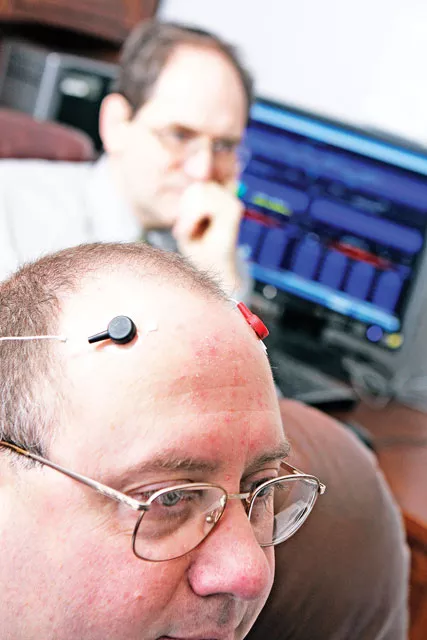
As a Marine, Erik Seiler served in the infantry from 2003 to 2007. His deployment resumé reads like a checklist of the last decade’s violent situations: Haiti in 2004; Fallujah, Iraq, in 2005; and Ramadi, Iraq, in 2006. Seiler says he first sought help for post-traumatic stress disorder (PTSD) after returning from Fallujah. “I had six months back [in the States], and then I had to deploy again. I used it to get my mindset prepared to deploy again.
“My last deployment was more intensive,” he continues. “Every day, I had to really just say it is OK to die. I had to be fine with it, so I could do my job the right way, otherwise I don’t think I could have done my job.”
After returning to his home in North Carolina, he found he couldn’t remember some critical events, “Guys would tell me, ‘But you were right there!’” More troubling was “the numbness,” he says. “People would tell me their problems, but it was like it didn’t matter to me.”
While he didn’t experience hallucinations, he says, “I had a lot of thoughts of carnage. I’d think about car wrecks, body parts laying around … I was extremely amped when I got back.” He particularly noticed a heightened level of “alertness and aggressiveness.”
Seiler isn’t alone. A study by the RAND Corporation estimated about 300,000 veterans, of the more than 1.5 million who served in Iraq and Afghanistan through 2008, suffered from what they termed “invisible wounds” — brain injuries and post-traumatic stress disorder.
PTSD can be triggered when a person experiences or witnesses a traumatic event in which grave physical harm occurred or was threatened. The person reacts to the event with a feeling of helplessness, terror or intense fear, and later — often for years — relives the event, while trying to avoid situations that trigger a memory of it. With more troops experiencing more frequent and longer deployments, researchers and clinicians are searching for ways to help veterans combat PTSD.
Neurofeedback is one option. Dr. Myron Thurber of Spokane Valley’s Neurotherapy Northwest explains that anytime a person has an experience or thought, it is the result of brain neurons firing in a specific pattern. The experience or thought is reproduced when the same group of neurons fire in the pattern that it fired in the past.
“With neurofeedback,” Thurber says, “we monitor that pattern and display it to the client who can begin to become aware of the pattern and through increased awareness can change those patterns … The person who is successful with neurofeedback that has experienced PTSD often notices a decrease in anxiety, re-establishes meaningful relationships, begins to sleep again and, when faced with previous triggers, can side-step the discomfort.”
After his last deployment, Seiler got in touch with Dr. Lanier Fly, a marriage and family therapist, in Newport News, Virginia, and began counseling combined with neurofeedback.
“It calmed me right down,” he says, “helped me get down to where I needed to be mentally to be here in the States.”
Eventually he was able to have his own machine. He uses it when situations, such as very warm temperatures like he experienced in Iraq, trigger a response. “When I felt really amped and hyper-vigilant,” he says, “I feel myself getting calmer throughout the session.” Sessions last 20 to 30 minutes, and Seiler supplements with consults with Dr. Fly when he is able to make the trip to see him, or by phone. “We usually start out talking a little bit, I get some stuff off my chest, he gets a feel for what I am feeling. He helps me have a better understanding of how to train myself.”
Seiler says he has been so pleased with the results of neurofeedback that he’s trying to introduce it to his fellow soldiers. “It is an awesome thing. I’ve had some friends come back and they’re pretty screwed up, and they go to all these doctors and get handed fistfuls of pills. Then they can get addicted to these drugs; it’s pretty easy to abuse them.”
Currently, the standard PTSD treatments are psychotherapy and antidepressant medications and other drugs. “There is more and stronger evidence for psychotherapy, specifically cognitive behavior therapy, for PTSD,” says Dr. Barbara O. Rothbaum, director of the Trauma and Anxiety Recovery Program at Atlanta’s Emory University School of Medicine.
The Veterans Administration provides two types of cognitive behavioral therapy. In “cognitive processing therapy,” a therapist helps a patient to understand his or her feelings about traumatic experiences. The therapist guides a patient to find a balance in beliefs about self-esteem, trust, safety and control that changed after the trauma. “Prolonged exposure therapy” aims to decrease stress about the traumatic event by repeated exposure — generally through conversation with the counselor — of trauma-related thoughts, feelings and situations, which the PTSD sufferer normally tries to avoid.
Not everyone is comfortable with that discussion, however. “Some of our clients with PTSD are uncomfortable in talking about their experiences,” says Thurber. Neurofeedback does not require a PTSD sufferer to explore or expose past trauma. “We simply move forward,” he says, “and focus on creating or reinforcing the patterns and experiences that match what the client wants rather than focusing on what the client doesn’t want.”
Neurofeedback proponents acknowledge more research on its effectiveness is needed. A number of neurofeedback studies are underway, but so far the best clinical results seem to come from some combination of therapies.
Thurber draws a clear line between neurofeedback and traditional psychotherapies. Neurofeedback, he says, “is really a way to find and enhance well-being rather than rehash the trauma.”
GETTING HELP
Homecoming4veterans is a national outreach organization offering free neurofeedback services to veterans. Information on participating providers is available at their website, homecoming4veterans.org.
